Zeresenay Alemseged doesn’t remember the 1974 discovery of the famous fossil Lucy at Hadar in Ethiopia, because he was 5 years old, living 600 kilometers away in Axum. Later he saw Lucy’s name on cafes and taxis, but he knew little about her until he became a geologist working at the National Museum of Ethiopia. Then, she changed his life.
In 2000, Alemseged was swept into Lucy’s orbit: He discovered “Lucy’s child,” a partial skeleton of a toddler of her species, at Dikika, 10 kilometers from Hadar. In 2015, by then a well-known scientist, he had the honor of showing Lucy to then-President Barack Obama before a state dinner at Ethiopia’s National Palace. Alemseged allowed Obama to touch the prized skeleton, telling him the fossil shows Ethiopia is the birthplace of humankind and that “every single person” on the planet shares an origin in Africa. “Including Donald Trump,” Alemseged joked to Obama.
Fifty years after her discovery, “Lucy is an icon,” says Alemseged, now a paleoanthropologist at the University of Chicago.
Indeed, the 3.18-million-year-old has reigned as the matriarch of the human family ever since she was announced as the earliest known ancestor of our genus, Homo, as well as of all other hominins that came after her. Heads of state paid court to her. Scores of Texans lined up to see her in 2006 when she made a U.S. tour, which was controversial because many scientists thought she was too fragile to travel. Even Ivanka Trump got an audience. But like many aging monarchs, Lucy now faces a new world, rife with competition for attention and status from her extended family.
Five decades of research have brought Lucy to life, showing how she walked upright even though she still had a small brain and apelike upper body, which probably allowed her to climb trees to feed, nest, or escape predators. More than 400 newer fossils of males and females, as well as the Dikika child, have revealed how her species, Australopithecus afarensis, grew, socialized, and evolved during its million-year span on the planet, from perhaps 3.85 million to 2.95 million years ago.
But researchers’ view of Lucy’s world and her place in it has changed. She is no longer the earliest known member of the human family. Members of her species didn’t take their first upright steps in open savanna grasslands, as her discoverers thought, but walked first in a grassy woodland with deciduous trees. She and her kind weathered climate change, adapting to different habitats over the millennia. Most important, she wasn’t alone in the landscape. “We have multiple [hominin] species in the same time period,” says Yohannes Haile-Selassie, director of the Institute of Human Origins (IHO) at Arizona State University, who is coorganizing a symposium this week on Lucy’s impact on human origins research.
Haile-Selassie and some others think that 3 million to 4 million years ago, the human family tree was more like a bush than a bonsai, with multiple stems growing side by side rather than a single trunk. He and others now see Lucy as more of a great-great-great-aunt than a direct human ancestor. But Alemseged and others point out that so far, no other fossil is a better candidate for being the mother of us all.
Even as paleoanthropologists debate her place in the human family tree, they agree no known human ancestor has had the impact of Lucy. They still marvel at the detailed view of our past revealed by her skeleton. Forty percent complete, it has served as a template for fitting together the isolated bones of dozens of other members of her species, like pieces in an incomplete puzzle. “More people have come to look and analyze Lucy’s skeleton than any other fossil in the world,” says IHO paleoanthropologist Kaye Reed.
Back in 1974, researchers didn’t realize just how rare such a well-preserved hominin skeleton would turn out to be. “Fate played a miserable trick—it gave us the best fossil early on,” says paleoanthropologist Bernard Wood of George Washington University. “It’s as if it’s my birthday and I’ve opened my first present and it’s exactly what I want … so you think that all the other presents will be as good as this one.”
THAT FOSSIL GIFT of a lifetime was first unwrapped by Don Johanson. Then a young American paleoanthropologist at the Cleveland Museum of Natural History, he had joined an expedition at Hadar organized by late French geologist Maurice Taieb. On 24 November 1974, halfway through the second field season, Johanson and student Tom Gray were walking back to their Land Rover after a discouraging morning when they had found little of interest. Then, Johanson saw a bit of Lucy’s arm bone on a hill in a dry gully. Next he spotted a skull piece, a thighbone, part of a pelvis, and vertebrae: a rare partial skeleton.
The team celebrated the discovery in camp, drinking beer and blasting the Beatles’s song Lucy in the Sky with Diamonds all night. Someone started to call the skeleton Lucy, and the name stuck.
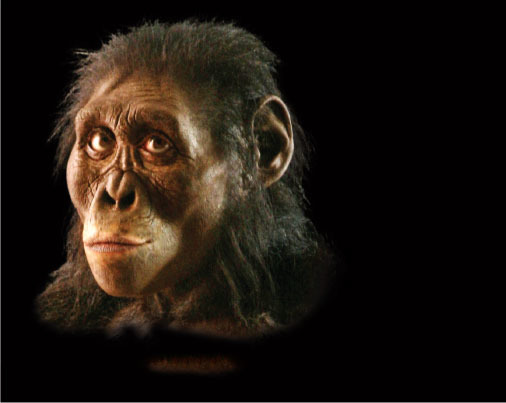
Photo: John Gurche
LUCY THE HOMININ
AGE: 3.18 million years old
SPECIES: Australopithecus afarensis
SIZE: 1 meter tall, 30 kilograms
FAMILY: All of Homo and Australopithecus, but it’s complicated
HOMETOWN: Hadar in Ethiopia. Now resides at the National Museum of Ethiopia in Addis Ababa
LIKES: Wooded grasslands, for walking upright and climbing trees to escape predators. Enjoys figs, berries, sedge grasses
KNOWN FOR: Good bones; well-preserved skeleton includes jaw, ribs, pelvis, and parts of arms and leg
DISCOVERED: 24 November 1974
NAMED AFTER: A Beatles song
“The real importance of Lucy is we didn’t know what an early human ancestor looked like,” says Johanson, founder of IHO. He recalls that he was immediately impressed by how small and primitive Lucy was compared with known members of Australopithecus, such as A. africanus, a hominin found in South Africa almost a century ago, and thought at the time of Lucy’s discovery to be about 2 million years old. “I was struck by her more apelike features,” he says.
Lucy was the first hominin to break the 3-million-year time barrier, pushing back the age of the human family to a time closer to when geneticists thought the ancestor of humans had split from the ancestor of chimpanzees. Lucy “entered a field actively debating the antiquity of the chimp/human split,” says Tim White, a paleoanthropologist at the University of California, Berkeley who coauthored the landmark 1978 paper describing Lucy’s species with Johanson and the late paleoanthropologist Yves Coppens.
For the first 20 years after Lucy’s discovery, her species was the oldest known member of the human family. A. afarensis was “the only game in town” between 3 million and 4 million years ago, says Carol Ward, a paleoanthropologist at the University of Missouri. Many researchers concluded that her species gave rise to all the hominins that came later, including Homo, A. africanus, and more robust members of the human family such Paranthropus aethiopicus, P. robustus, and P. boisei.
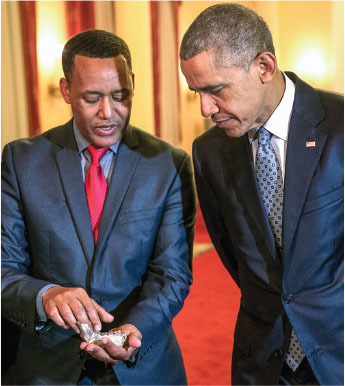
Zeresenay Alemseged (left) showed Lucy’s jaw to then-President Barack Obama in Addis Ababa, Ethiopia, in 2015. PHOTO: EVAN VUCCI/AP
“Once upon a time, life was relatively simple because anything before 3 million years was A. afarensis … [and] it was the mother of us all,” says paleontologist Fred Spoor of the Natural History Museum in London. “That was the gospel.”
Since then, however, other species have emerged from the shadows, some of them much older. Lucy was so apelike that “the implicit hypothesis was that the next step back would be a chimpanzee,” says White, who found fossils and analyzed footprints of Lucy’s species at Laetoli in Tanzania. “How quaint that seems today.”
In the mid-1990s, White, then–graduate student Haile-Selassie, and others began an intense search for Lucy’s ancestors in the Middle Awash region of Ethiopia. They found a remarkably complete but crushed partial skeleton they named Ardipithecus ramidus, dated to 4.4 million years ago. Nearby, Haile-Selassie later found the lower jaw, teeth, and disarticulated bones of the hands, feet, and arm of Ardipithecus kadabba, dated to 5.8 million years ago. These primitive hominins looked more like upright apes than humans. “You wouldn’t invite [them] to dinner,” White joked. Ardipithecus, he says, “makes Lucy and Co. downright humanlike in comparison.”
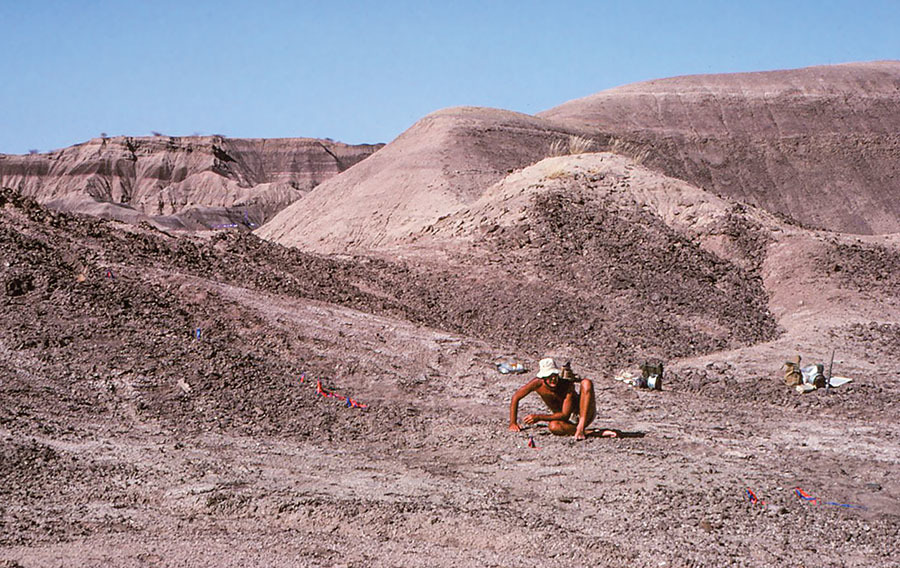
The day after he found Lucy in November 1974, Don Johanson studies the exact spot where he picked up the first bone, her elbow. PHOTO: BOBBIE BROWN
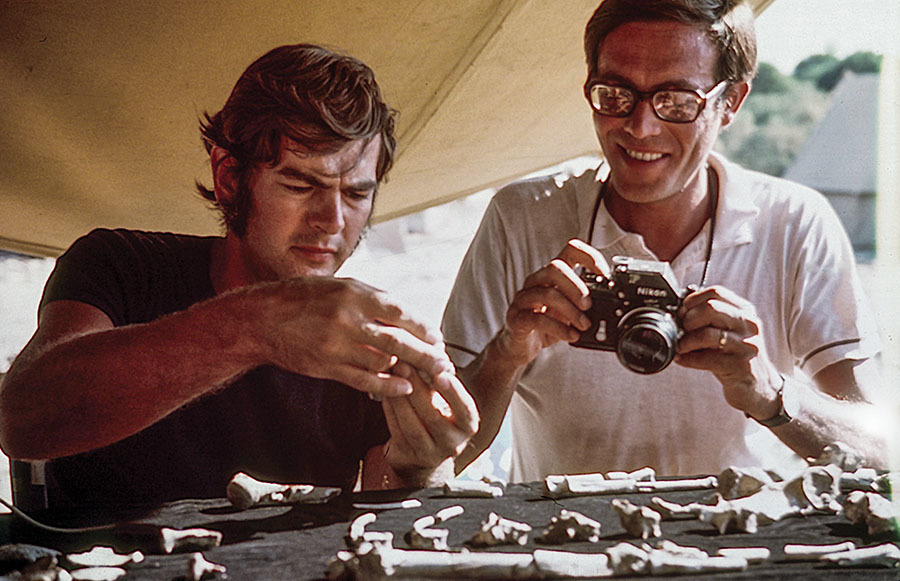
In camp, Johanson (left) and Maurice Taieb scrutinize and photograph the spectacular find. PHOTO: INSTITUTE OF HUMAN ORIGINS
Other new fossils pushed the human lineage even older: a 6-million-year-old thighbone from an apparent upright walker from Kenya called Millennium Man, or Orrorin tugenensis; and a stunning skull of Sahelanthropus tchadensis, dated 6 million to 7 million years old, from Chad.
Anthropologists still fiercely debate whether all these species are hominins, and how they relate to Australopithecus, not to mention Homo. But the fossils clearly push back the origin of the human family to at least 6 million years ago, a date that dovetails with the most recent genetic evidence for the timing of the split between our lineage and that of chimps and bonobos.
Meanwhile, other researchers kept seeking fossils in the key period about 4 million years ago—and found what seemed to be a great-grandmother for Lucy. In 1994, Kenyan paleoanthropologist Meave Leakey and her team found more than 80 fossils of teeth, jaws, a partial arm, and shinbone at two sites near Lake Turkana in Kenya. They dated the fossils to between 3.9 million and 4.2 million years ago, and named the species Australopithecus anamensis. Based on features of its teeth and jaw, they proposed the new species was the direct ancestor of Lucy and her kin.
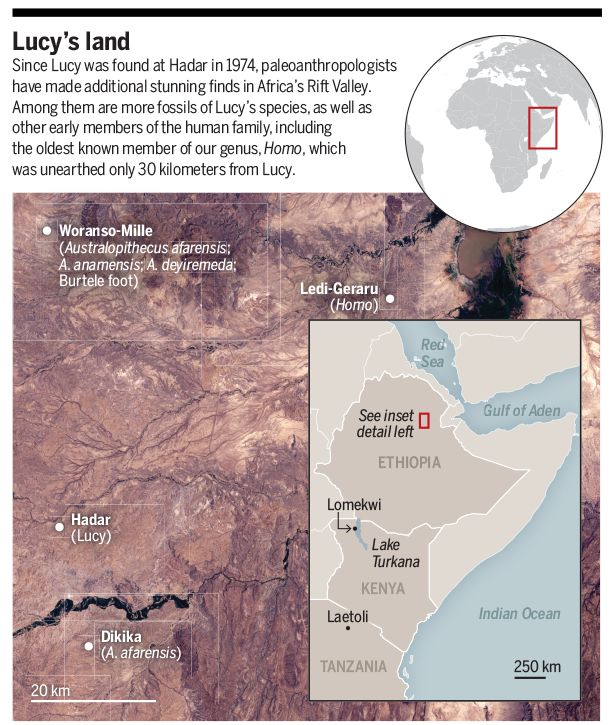
CREDITS: (GRAPHIC) D. AN-PHAM/SCIENCE; (DATA) U.S. GEOLOGICAL SURVEY
Then in 2016, in a hilly area just 30 kilometers from Hadar called Woranso-Mille, Haile-Selassie made a discovery that complicated the picture. With help from a local goat herder, he found the first complete skull of A. anamensis. The stunning skull dated to 3.8 million years ago, a bit younger than the earliest fossil attributed to Lucy’s species, a jaw dated to 3.85 million years. The notion that A. anamensis had evolved directly into Lucy’s species and then vanished was off the table. Instead, perhaps an earlier member of A. anamensis—or even another closely related species—gave rise to A. afarensis, and the two lineages coexisted for a time.
Even as they sought Lucy’s ancestors, paleoanthropologists also kept searching for her descendants, looking for a path from her genus to our own.
IDENTIFYING THE DIRECT ANCESTOR of Homo is challenging, Ward says, in part because “we don’t know much about early Homo.” The earliest known fossil of our genus is a lower jaw with worn molars, dating to almost 2.8 million years ago and found at the desolate site of Ledi-Geraru, only 30 kilometers from Hadar (see map, above). “It’s a convincing case,” Ward says, “but it’s just one mandible until about 2 million years ago,” when at least two members of the genus, Homo habilis and H. erectus, appear elsewhere in eastern Africa.
The jaw’s age suggests Homo made its entrance about 3 million years ago, not long after Lucy lived. But there are new contenders to be ancestors of Homo, because at that time, eastern Africa appears to have been home to a diverse set of hominins (see graphic, p. 25).
One is known from a strange crushed skull dating to 3.5 million years ago, which Leakey’s team found at Lomekwi on the west side of Lake Turkana in 1999. She and Spoor painstakingly reconstructed the skull fragments like pieces in a 3D puzzle. They concluded they had a new species, Kenyanthropus platyops, with a flatter face and smaller molars than Lucy’s species—traits suggesting it was intermediate between Lucy and Homo.
With only that crushed skull, however, Kenyanthropus got a mixed reception. White called it roadkill and suggested it was a smashed A. afarensis. More recently, Spoor and Leakey applied 3D morphometric methods to compare Kenyanthropus’s upper jaw with those of a half-dozen other hominins, and convinced many researchers to take it seriously as a separate species. Researchers identified additional isolated teeth of the species at Lomekwi, but the species is still poorly known.
Meanwhile, Haile-Selassie found two additional hominins at his site of Woranso-Mille that further tangle the human family tree just before Homo appeared. One, the Burtele foot, named after the 3.4-million-yearold layer of sediment in which it was found, lived at the same time as A. afarensis but is more primitive, with an opposable big toe like that of tree-climbing Ardipithecus. His team also found teeth and two upper and two lower jaws he attributes to a new species he named A. deyiremeda that lived 3.3 million to 3.5 million years ago. When he published the discovery in 2015, reaction was mixed; White, Alemseged, and others thought the jaws were diverse forms of A. afarensis, which was found within 5 kilometers of the site.
But Spoor and his postdoc recently backed Haile-Selassie’s claim. They did a 3D morphometric analysis of developmental differences in the upper jaw bones of A. afarensis, A. deyiremeda, and K. platyops, highlighting the methodological advances in the field since Lucy was found. The comparisons “demonstrate significant differences,” Spoor argued in a talk at the College of France in June 2023. “It confirms the status of K. platyops and A. deyiremeda as valid species different from A. afarensis.”
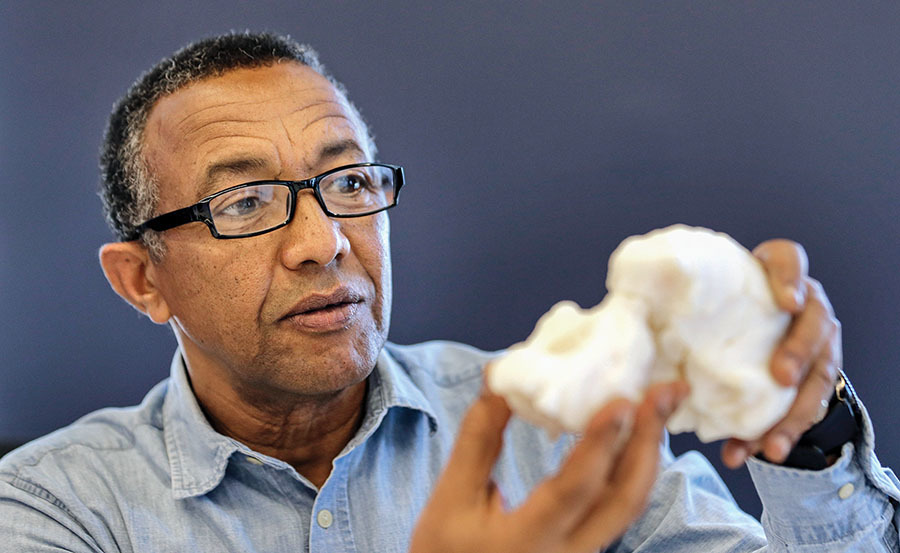
Yohannes Haile-Selassie unveils a replica of the 3.9-million-year-old skull of Australopithecus anamensis, which many think is the ancestor of Lucy’s species. PHOTO: SETH WENIG/AP
No one is arguing that A. deyiremeda is a closer ancestor to Homo than Lucy. But the new fossils suggest a burst of diversity 3.5 million years ago, crowding the stage on which Lucy once stood alone. She may have been part of an adaptive radiation that happened earlier than researchers once thought, perhaps after hominins began to walk upright and expanded their habitats and diets, Ward says.
Some of those hominins may have trod the same ground as Lucy’s species. In 2020, paleoanthropologist Charles Musiba of the University of Colorado Denver and his colleagues reanalyzed famous tracks discovered in 1976 at Laetoli. Some prints are thought to be the footprints of A. afarensis about 3.7 million years ago. Other tracks, about the same age, were believed to have been made by animals. Musiba and his colleagues, however, proposed that the prints were made by upright walkers—a hominin with different feet and gait from Lucy’s species.
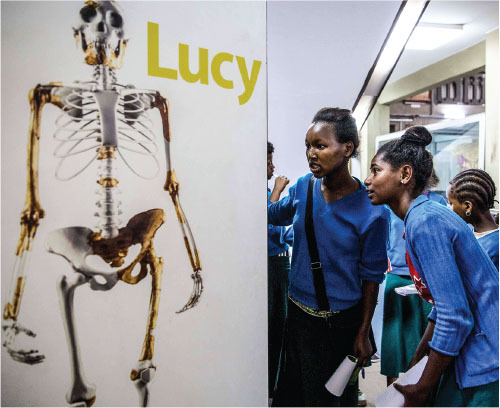
Lucy is a national treasure in Ethiopia, where students and others often visit her skeleton at the National Museum of Ethiopia in Addis Ababa. PHOTO: IMAGO/ALAMY
Meanwhile, another clue in the search for ancestors has emerged in South Africa, where researchers have discovered other early members of Australopithecus, such as A. sediba, dating to about 2 million years ago and possibly earlier. A new analysis in the Journal of Human Evolution last year could not rule out that A. sediba shared an ancestor that also gave rise to early Homo, raising the possibility that our ancestor ranged from eastern Africa to South Africa.
At the moment, none of the new hominins is convincing as a direct forebear of Homo. Alemseged and some others still put their money on Lucy: They point out that no fossils unequivocally bump her species from its prime spot as the putative ancestor of early Homo and later members of Australopithecus.
Others say we just don’t know. “It’s too simplistic to create ancestor-descendants out of currently known species from an incomplete fossil record,” Spoor says. Given the rarity of fossilization for hominin remains and how few have been found, we might never catch a glimpse of our immediate direct ancestor, Wood says. It’s unlikely that “all the hominins that ever lived occupied the circa 1% of the land surface of Africa where we happen to find fossils,” he says.
LUCY’S STATUS as a human ancestor may be uncertain, but in other ways she is coming into sharper focus. “When Lucy was found, we thought Homo habilis was the one who made the earliest tools,” says archaeologist Sonia Harmand of the French national research agency CNRS. But at Lomekwi, where Kenyanthropus was found, Harmand and her team unearthed crude stone tools from 3.3 million years ago, early enough for either Kenyanthropus or an Australopithecus to have hafted them. Lucy’s brain was only a bit bigger than an ape’s relative to her body size, but her hand and that of other members of Australopithecus was probably capable of smashing bones for marrow with crude tools, Harmand says.
“We don’t know if Lucy was a toolmaker,” Harmand emphasizes. “Unfortunately for her, she has a lot of competition” from other hominins alive at the time. So far the team has reported only a single, strange-looking molar found with the tools, although other teeth and fossils may be published soon and could clarify the toolmaker’s identity.
Others have suggested Lucy’s kind could have made tools. Back in 2010, Alemseged and Shannon McPherron of the Max Planck Institute for Evolutionary Anthropology wrote in Nature that a rib and a shaft of an ungulate leg bone bear “unambiguous evidence” of stone tool marks, made 3.4 million years ago by a member of the human family. The butchered bones were found at Dikika, just 222 meters from the spot where Alemseged discovered the remarkably complete Dikika child. White and others, however, argue the cut marks could be the work of crocodile teeth rather than stone tools. And no tools have been found at Laetoli or Hadar, where most of the hundreds of A. afarensis fossils have been found, says paleoanthropologist Terry Harrison of New York University.
Still, Lucy’s adaptability is clear from studies of the ancient environments she lived in for hundreds of thousands of years. Teams of researchers are identifying ancient animals from bones and proteins and studying pollen, plant waxes, and isotopes to reconstruct vegetation and rainfall. They’ve found that when the earliest A. afarensis lived at Hadar about 3.7 million years ago, the site included woods along the shore of an ancient river, where animals waded into floodwaters and an entire family of A. afarensis died together.
Later, after 3.2 million years ago, Hadar was much drier, and Lucy’s species adapted to a new diet with tougher foods such as sedges, roots, and grasses; apparently in response, male members of A. afarensis evolved bigger jaws. Farther south at Laetoli the habitat was even drier—a “marginal environment” without a stream when A. afarensis was there, says IHO paleoanthropologist Denise Su. “Basically, afarensis was a generalist,” able to survive in a host of environments, Reed says.
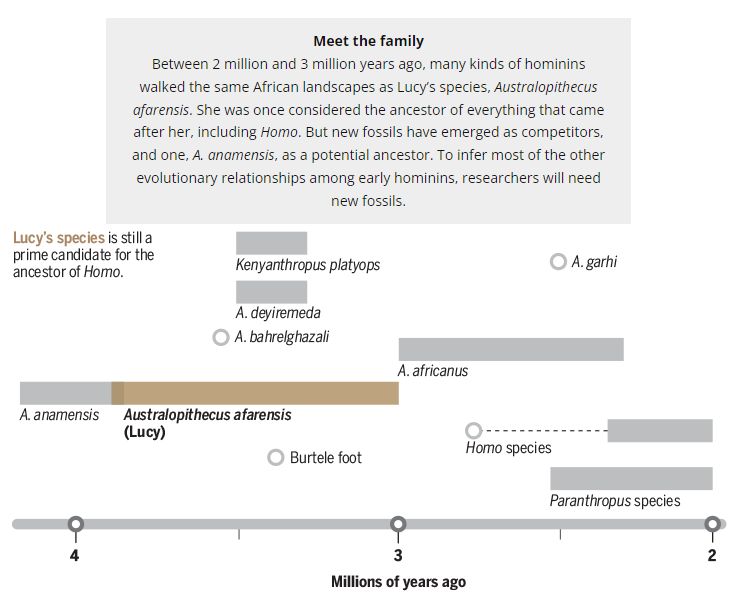
CREDITS: (GRPAHIC) D. AN-PHAM/SCIENCE; (DATA) F. SPOOR, NATURE, 10.1038/521432A (2015)
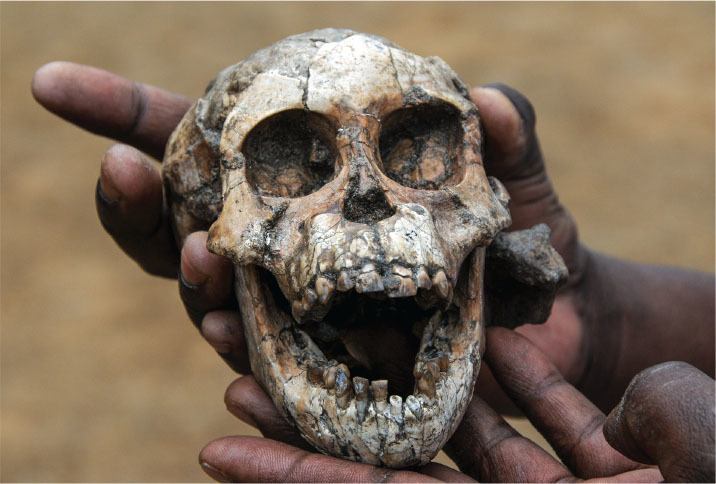
Zeresenay Alemseged cradles the skull of “Lucy’s child,” a toddler of her species he found at Dikika in Ethiopia. PHOTO: EALISA WESTERHOFF/AFP VIA GETTY IMAGES
Lucy’s species was the only known hominin at Hadar. Yet only 30 kilometers away at Woranso-Mille, it shared the steeper, more wooded terrain with A. anamensis and A. deyiremeda, as well as the owner of the Burtele foot. Reed and Haile-Selassie aim to figure out why one site has so many hominins and the other only one. Haile-Selassie thinks the greater diversity of habitat at Woranso-Mille may have allowed different hominins to coexist in different niches. He was back in the field in February, seeking more bones and tools.
Yet even as he searches for fossils to supplant her, he and others say Lucy’s reign continues. “I don’t think there has been anything that has successfully displaced Lucy,” Wood says. “That doesn’t mean she was the ancestor of Homo. But she’s still the best candidate.”
That’s good news for Johanson, now 80 and just back from Ethiopia, where he found many young people still eager to take selfies with Lucy’s discoverer. Wherever Lucy ultimately lands in the human family tree, Johanson has only one regret: He didn’t get to introduce her to the Beatles.
Ann Gibbons, the primary writer on human evolution for Science magazine for more than a decade, has taught science writing at Carnegie Mellon University. She has been a Knight Science Journalism Fellow at Massachusetts Institute of Technology and a Science Journalism Fellow at the Marine Biological Laboratory in Woods Hole, Massachusetts. She lives in Pittsburgh, Pennsylvania. www.anngibbons.com
Make an Impact With Your Subscription
With a readership of more than one million, Science, published by AAAS, is the world’s leading outlet for scientific news and cutting-edge research. Every week, you will receive invaluable content made for STEM enthusiasts who are shaping the future.
From exploring ripples in spacetime to quantifying the impact of emissions on our climate, Science puts you at the forefront of what’s new in STEM as we collectively build what’s next.
Science is more than just a magazine. Subscribers, like you, make up a community that’s dedicated to driving scientific progress that benefits everyone. When you join AAAS, you’re directly helping us promote diversity in STEM, support educational opportunities for underserved communities, engage policymakers on issues like climate change, and much more.
Join AAAS today to unlock the benefits of membership, including:
Digital and print subscriptions to Science
Archival Science access dating back to 1880
Subscriptions to the highly cited Science family journals
Invitations to AAAS Member events
An exclusive gift for new members
Breaking news and much more!
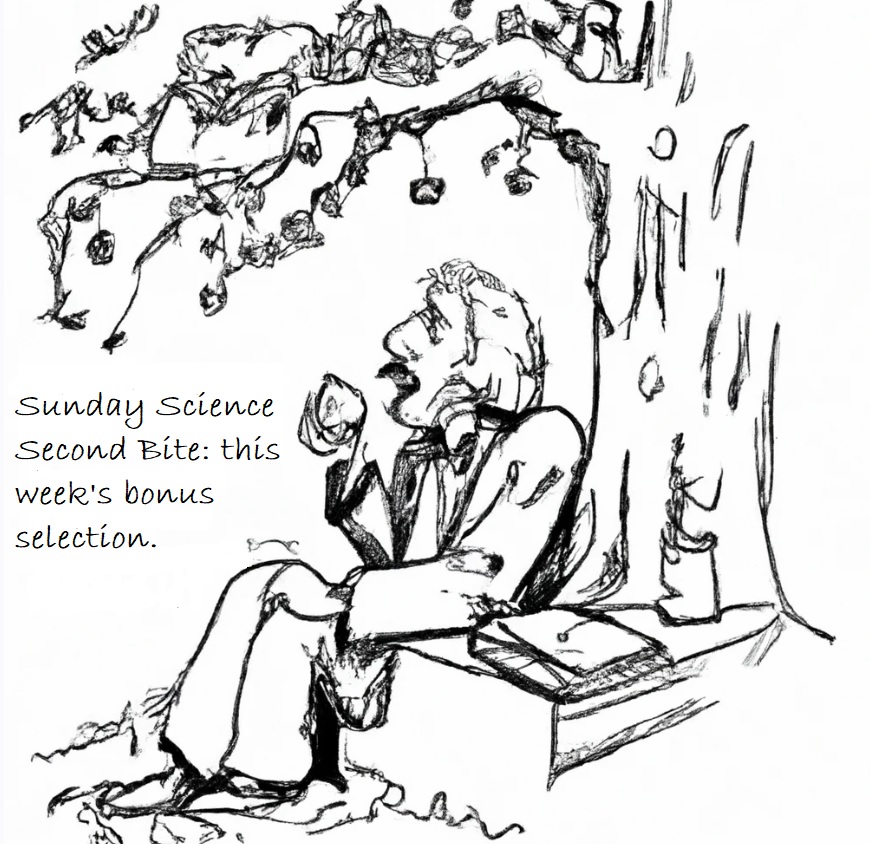
What was it like when oxygen killed almost all life on Earth?
Ethan Siegal
Known as the Great Oxygenation Event, Earth froze over as oxygen accumulated in our atmosphere, nearly driving all life extinct.
Starts With A Bang / Big Think
April 1, 2024

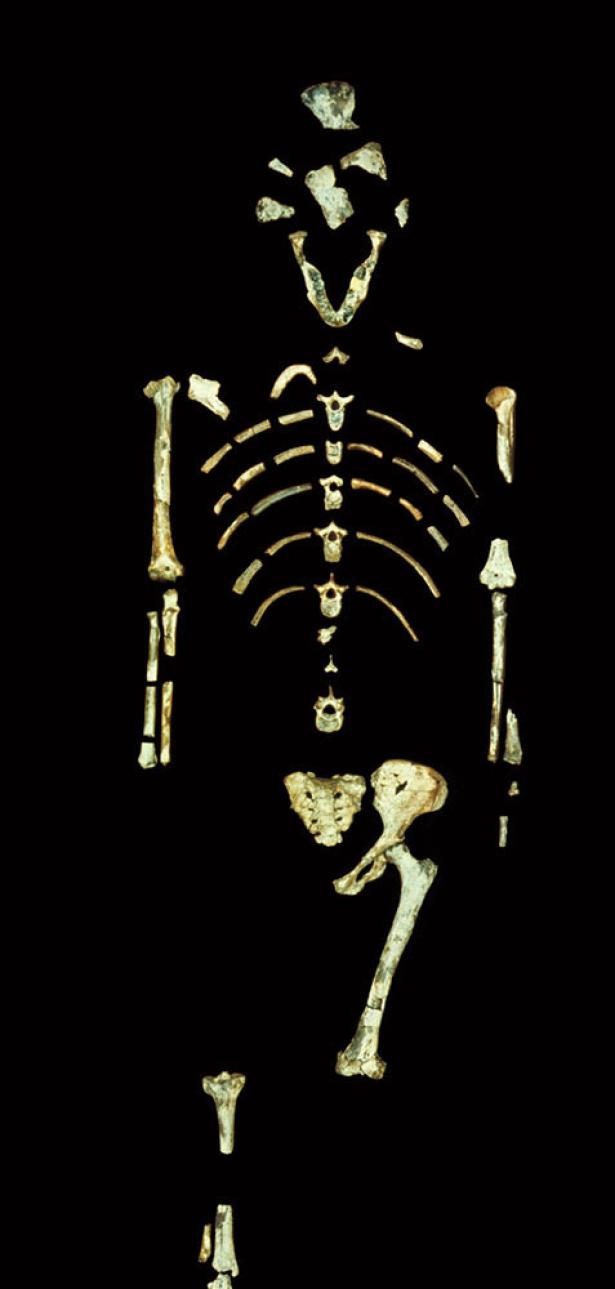
Spread the word